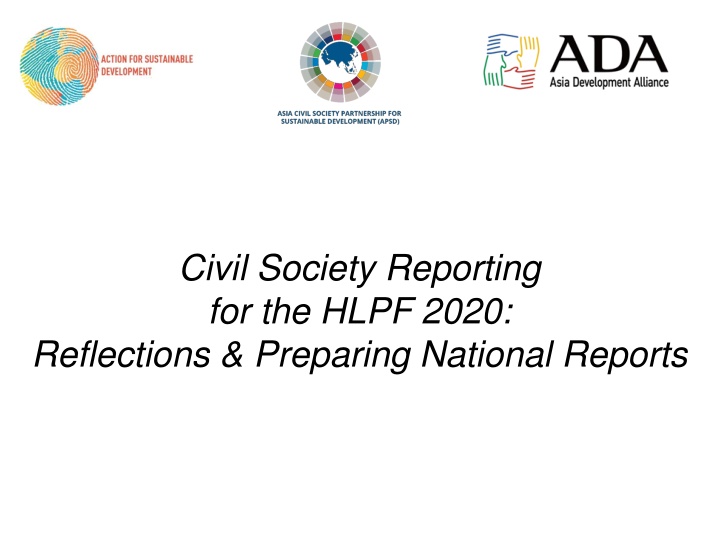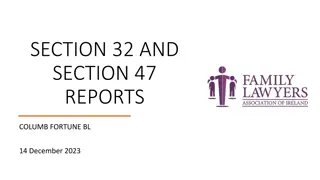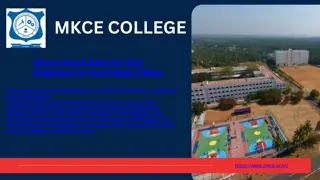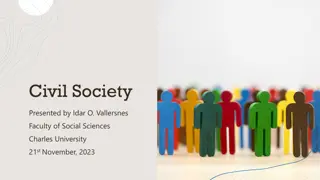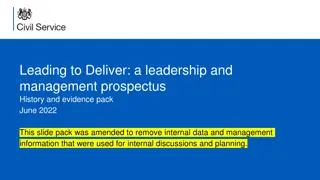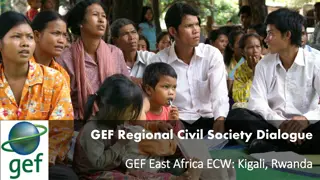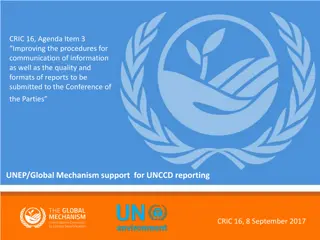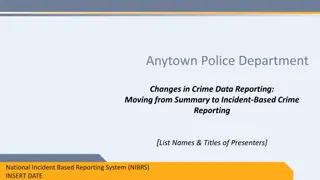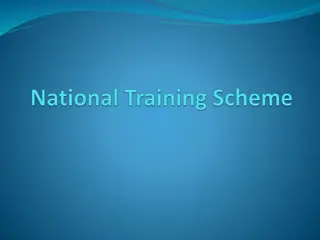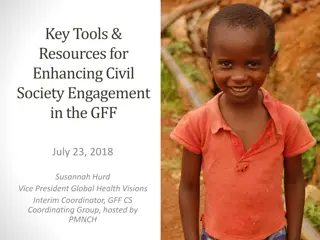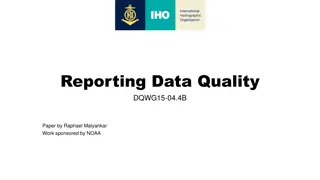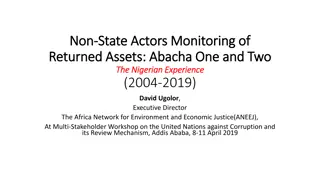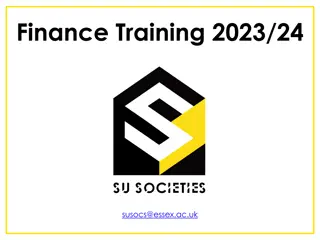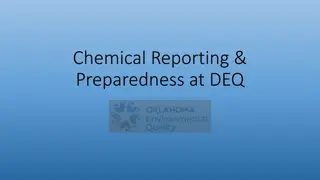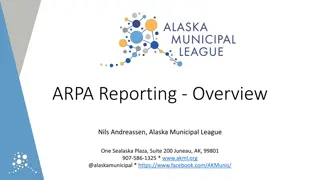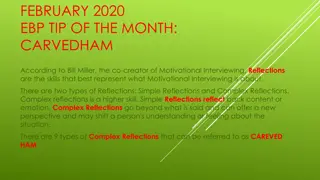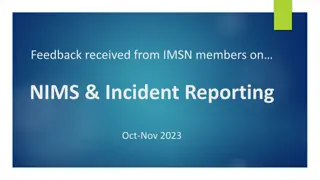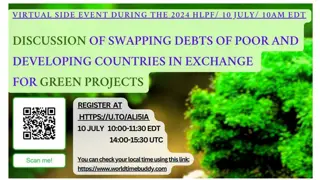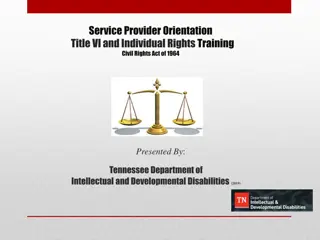Civil Society Reporting for the HLPF 2020 Reflections & Preparing National Reports
Joint webinar discussing civil society engagement, VNR reporting, lessons learned, and the importance of reporting according to UN guidelines for advancing the Sustainable Development Goals. Insights shared on the role of civil society in the 2030 Agenda, national reporting preparations, and challenges faced in SDGs implementation.
Download Presentation

Please find below an Image/Link to download the presentation.
The content on the website is provided AS IS for your information and personal use only. It may not be sold, licensed, or shared on other websites without obtaining consent from the author.If you encounter any issues during the download, it is possible that the publisher has removed the file from their server.
You are allowed to download the files provided on this website for personal or commercial use, subject to the condition that they are used lawfully. All files are the property of their respective owners.
The content on the website is provided AS IS for your information and personal use only. It may not be sold, licensed, or shared on other websites without obtaining consent from the author.
E N D
Presentation Transcript
Civil Society Reporting for the HLPF 2020: Reflections & Preparing National Reports
Joint Webinar 21 Jan 2020 1. Opening & Introduction: Jyotsna Mohan Singh (5 mins) 2. Presentation on civil society engagement and the People s Scorecard: Oli Henman (15 mins) 3. Learning and proposals for improving VNR reporting: Deirdre De Burca, Forus (10 Mins) 4. Presentation of previous VNR experience: 1. Sri Lanka (Uchita de Zoysa) 10 Mnts 2. Kazakhstan (Jamila Asanove) 10 Mnts 3. Cambodia (Sovanna Ry) 10 Mnts 5. Current VNR country: 1. India (Lubna) 10 Mnts 2. Nepal 10 Mnts 6. Wider Countries- Q&A with participants (35 Mins) 7. Way Forwards Jyotsna (5 Mnts)
Civil Society Engagement Civil society plays a key role in the 2030 Agenda by: - monitoring (watchdog function) - representation (analysis, citizen voice and citizen experience) - realization (has implementation happened and how)
National Civil Society Reporting for the HLPF 2020: Reflections & Preparing People s Scorecards Oli Henman, Global Coordinator, A4SD oli.henman@action4sd.org
Lessons learned from first 4 years (Progressing National SDGs implementation) 1. Majority of countries now provide space for formal stakeholder engagement 2. Most countries have provided a baseline of data 3. However 2019 saw a reduction in focus on means of implementation and financing 4. More countries refer to leaving no one behind but actual targeted support is still insufficient 5. Limited demonstrable progress in the transformative potential of the 2030 Agenda 6. Member states still not making the most of mutual learning
Reporting according to UN guidelines Majority of countries include most elements of the common reporting guidelines Improvement in terms of including the 3 dimensions of sustainable development but Reports are often not structured according to guidelines which limits comparability Limited details on challenges and lessons learned, best practice, details on areas in which countries would like to learn from others and identification of priorities for support
A4SD Survey of Civil Society members Information sharing alone is not sufficient, real dialogue with civil society is needed- national consultation processes are not yet open, inclusive of all people, participatory and transparent Make Leave No One Behind a higher priority Civil society partners demand the right to provide inputs to whole of society reviews Particular improvements are needed at national and regional level, to include: greater civil society coordination for analysis and dialogue ongoing independent analysis of progress citizen generated evidence Establish better links from regional to global level meetings Improve support to stakeholders, including resources and capacity development
How to use the template for a Peoples Scorecard 2020 is the fifth year, start of second cycle- some countries are already reporting for second (or even third) time Civil society often produces a shadow / spotlight report responding to the government s own analysis It s now time to go further and develop our own independent analysis, eg. Sri Lanka, Brazil, Kenya Be aware- this will require a strong core team!
A) Overview of current country implementation 1. Assessment of mainstreaming and integration of the 2030 Agenda and the 17 SDGs across national policies and implementation, focus on the three dimensions of sustainable development: social, environmental and economic 2. How far the whole of government approach is carried out for SDG implementation 3. How the key cross-cutting principles as Leaving No One Behind and Respecting Planetary boundaries are included in all policies, and any gaps identified. 4. Analysis of financial mechanisms and resource; also what other kinds of partnerships have been set up, what is the role of different actors (including private sector) and which donors are involved?
B) Convene national multi-stakeholder dialogues Convene dialogues across civil society to identify shared priorities At least one national meeting and where possible at least 3 sub-national meetings bringing together a cross-section of organisations working on the key topics of the SDGs, including: poverty, food, biodiversity, water and sanitation, equality, climate, transport, urban planning, governance etc
B) Convene national multi-stakeholder dialogues- LNOB Ensure the national coalition crosses different sectors and includes different constituency groups, as well as contains a geographic (urban and rural), age, disability and gender balance Ensure that as many as the following groups are included in your dialogue: women and girls, persons with disability, trade unions, young people, older people, Indigenous peoples, small scale farmers, environmental activists, LGBTQI, Religious and ethnic minority groups
C) Review of the 17 Goals & Summary Report Conduct evidence-based assessments, using disaggregated data and citizen generated evidence on the progress and challenges of the 17 SDGs Consider availability of data as well as potential gaps in evidence, including identifying what official data exists plus cross-reference with local citizen generated data sources where possible Look at key Goals and principles and potential clusters around key issues for your country context.
C) Review of the 17 Goals & Summary Report- analysis framework 1 No Policy/Plan 2. Initial planning phase 3. Plans or actions started 4. Delivery underway 5. Succesful implementation Strong Policy/legal framework in use a) No/weak Policy/legal framework available Policy/legal framework in planning phase Some Policy/legal framework available Policy/legal framework agreed b) No/weak plans and strategies exist Plans & strategies in planning stage Some Plans and strategies exist Plans & strategies agreed Strong Plans and strategies exist c) No/weak Agencies with clear mandate available Agencies planning their engagement Some Agencies with clear mandate available Agencies beginning to develop their implementation Strong Agencies available with clear mandate d) No/weak implementation of policies, plans and strategies on regular basis Implementation of policies, plans and strategies in planning phase Some implementation of policies, plans and strategies on irregular basis Implementation of policies, plans and strategies has started across all areas Strong implementation of policies, plans and strategies on regular basis e) No/weak Awareness and capacity building available Planning on awareness and capacity building needs Some Awareness and capacity building available Awareness & capacity building activities are beginning Strong Awareness and capacity building available f) No baseline indicators set Planning and consultation on baseline indicators Some baseline indicators set Baseline indicators being finalised Strong baseline indicators set g) No/weak monitoring, evaluation & reporting is available Monitoring, evaluation & reporting plans are agreed Some monitoring, evaluation & reporting is available Monitoring, evaluation & reporting underway on all Indicators Regular monitoring, evaluation & reporting is available h) No access to information is available Initial agreement on access to information Some access to information is available Access to information is underway on all Indicators Strong access to information is available i) No/weak transparency and accountability mechanism available Initial planning for transparency & accountability mechanism Some transparency and accountability mechanism available Transparency & accountability mechanism being implemented across all Indicators Strong transparency and Accountability mechanism available
C) Review of the 17 Goals & Summary Report- Goal example Goal 1 End Poverty in all its forms everywhere Has the government created a specific plan and begun implementation to tackle this goal nationally? Are other levels of government (local, provincial) involved in implementing this goal? What is the evidence base being used to measure implementation, is it disaggregated and is it transparent and freely available? Has civil society been involved in setting out the implementation strategy; planning approach; and in defining the evidence base? Any additional comments for this goal or plan? How do you assess the effects of this Goal s implementation on other Goals and towards achieving sustainable development as a whole? What are the other key Goals you see complementing achieving this Goal? Overall rating 1-5:
C) Review of the 17 Goals & Summary Report Finally: develop a Summary that provides a qualitative analysis of the interlinkages between goals This should include potential trade-offs that are being considered, eg. increased economic growth at the same time as increased inequality and/or environmental degradation.
D) Hold a final consultation meeting to validate your findings Based on the Goal by Goal analysis, draft of full report should be shared Share the draft with your national partners in the first instance to enable a final chance for feedback and validation by civil society partners Once you have a consensus the report can be shared with government and used for wider advocacy
For more information please check our website: https://action4sd.org/tools-resources/ Contact: Oli Henman, Global Coordinator, A4SD oli.henman@action4sd.org
